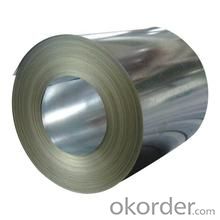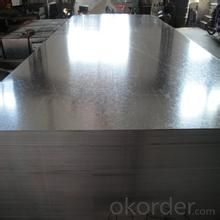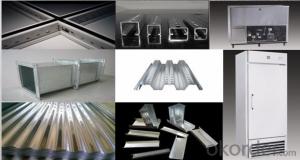Hot-dip Zinc Coating Steel Building Roof Walls in Best Price
- Loading Port:
- China main port
- Payment Terms:
- TT OR LC
- Min Order Qty:
- 50 m.t.
- Supply Capability:
- 10000 m.t./month
OKorder Service Pledge
OKorder Financial Service
You Might Also Like
Hot-dip Zinc Coating Steel Building Roof Walls
1.Structure of Hot-Dip Galvanized Steel Sheet Description:
Hot-dip galvanized steel coils are available with a pure zinc coating through the hot-dip galvanizing process. It offers the economy, strength and formability of steel combined with the corrosion resistance of zinc. The hot-dip process is the process by which steel gets coated in layers of zinc to protect against rust. It is especially useful for countless outdoor and industrial applications. Production of cold formed corrugated sheets and profiles for roofing, cladding, decking, tiles, sandwich walls, rainwater protective systems, air conditioning duct as well as electrical appliances and engineering.
2.Main Features of the Hot-Dip Galvanized Steel Sheet:
• Excellent process capability
• Smooth and flat surface
• Workability, durability
• Excellent anticorrosive property
• High strength
• Good formability
• Good visual effect
3.Hot-Dip Galvanized Steel Sheet Images



4.Hot-Dip Galvanized Steel Sheet Specification
Standard: ASTM, JIS,EN
Grade: CS, DX51D+Z,SGCC, SS 230~550,S220GD+Z~S550GD+Z, SGC340~SGC570
Thickness: 0.18mm~5mm
Width: max 2000mm
Coil weight:3-12 MT
Coil ID:508/610mm
Surface structure: zero spangle, regular spangle or minimum spangle
Surface treatment: Chromate treatment, Oiled/dry, skinpassed/non-skinpassed
Packing: Standard seaworthy export package
Technology test results:
Processability | Yield strength | Tensile strength | Elongation % | 180°cold-bending |
Common PV | - | 270-500 | - | d=0,intact,no zinc removal |
Mechanical interlocking JY | - | 270-500 | - | d=0,intact,no zinc removal |
Structure JG | >=240 | >=370 | >=18 | d=0,intact,no zinc removal |
Deep drawn SC | - | 270-380 | >=30 | d=0,intact,no zinc removal |
EDDQ SC | - | 270-380 | >=30 | d=0,intact,no zinc removal |
5.FAQ of Hot-Dip Galvanized Steel Sheet
We have organized several common questions for our clients,may help you sincerely:
1.How to guarantee the quality of the products?
We have established the international advanced quality management system,every link from raw material to final product we have strict quality test;We resolutely put an end to unqualified products flowing into the market. At the same time, we will provide necessary follow-up service assurance.
2. How long can we receive the product after purchase?
Usually within thirty working days after receiving buyer’s advance payment or LC. We will arrange the factory manufacturing as soon as possible. The cargo readiness usually takes 15-30 days, but the shipment will depend on the vessel situation.
- Q:How are steel coils labeled for identification?
- Steel coils are typically labeled for identification using stickers or tags that contain information such as the coil number, dimensions, weight, grade, and other relevant details.
- Q:which one(glass or steel)has more power and velocity? im planning on using my slingshot for hunting.
- definitely steel. i used to hit bullseyes with a good slingshot, and you need heavy, perfectly spherical small steel shot. smaller than a marble, bigger than a bb.
- Q:What are the environmental impacts of producing steel coils?
- The production of steel coils has several environmental impacts. Firstly, it involves the extraction of iron ore, which requires mining activities. These mining operations can lead to deforestation, habitat destruction, and soil erosion. Additionally, the extraction and processing of iron ore require large amounts of energy, contributing to greenhouse gas emissions and air pollution. Furthermore, the production of steel coils involves several stages, such as smelting and refining, which are energy-intensive and emit significant amounts of carbon dioxide, sulfur dioxide, and nitrogen oxides. These emissions contribute to air pollution, acid rain, and climate change. Water consumption is another notable environmental impact. Steel production requires large volumes of water for cooling and processing purposes. This high water demand can strain local water resources and potentially lead to water scarcity or pollution if not managed properly. Moreover, the steel industry generates substantial amounts of waste and by-products, such as slag, dust, and sludge. Proper disposal and treatment of these waste materials are crucial to prevent soil and water contamination. Lastly, transportation plays a role in the environmental impact of steel coil production. The transportation of raw materials and finished products can contribute to carbon emissions and air pollution, especially if long distances are involved. To mitigate these environmental impacts, various measures can be taken. Implementing more efficient production processes, such as recycling and using renewable energy sources, can reduce energy consumption and emissions. Additionally, improving waste management practices, investing in water conservation technologies, and optimizing transportation logistics can help minimize the environmental footprint of steel coil production.
- Q:How are steel coils used in the production of industrial storage tanks?
- Industrial storage tanks commonly utilize steel coils due to their superior strength and durability. These coils are typically crafted from high-quality steel that is rolled into a coil shape, enabling convenient transportation and handling. During the production process, steel coils are initially uncoiled and flattened to create steel sheets. These sheets are then cut and formed into the desired shape and size for the storage tank. The steel sheets are joined together through welding or bolting to construct the tank's body, which is designed to endure high pressure and heavy loads. The utilization of steel coils in the production of industrial storage tanks offers numerous benefits. Firstly, the strength and durability of steel ensure that the tanks can withstand harsh conditions and resist corrosion. This is particularly vital for storage tanks containing corrosive substances or exposed to severe environments. Moreover, the flexibility of steel coils permits customization of the tank's design and size. This is especially advantageous in industries with varying storage requirements, like the oil and gas sector. Steel coils can be effortlessly cut and molded into diverse shapes and sizes, facilitating the creation of storage tanks tailored to specific storage needs. Furthermore, steel coils are easily transportable and storable, making them a cost-effective choice for industrial storage tank production. The coils can be efficiently transported to the manufacturing facility, reducing transportation costs and logistical complexities. In conclusion, steel coils play a crucial role in the production of industrial storage tanks by providing strength, durability, and customization options. Their usage guarantees the safe storage and protection of various substances, rendering them indispensable in a wide range of industries.
- Q:How are steel coils used in the production of rail tracks?
- Steel coils are used in the production of rail tracks as they are processed and shaped into long sections known as rails. These coils are first uncoiled and then heated, allowing them to be rolled and formed into the desired rail shape. The resulting rails are then cut to the required length and undergo further processes such as straightening and finishing to ensure their strength, durability, and suitability for use in railways.
- Q:What are the different methods of painting steel coils?
- There are several methods of painting steel coils, including coil coating, spray painting, and powder coating. Coil coating involves applying a liquid coating to the surface of the steel coil, which is then cured and dried. Spray painting involves using a spray gun to apply paint to the coil, typically in multiple layers. Powder coating involves electrostatically applying a dry powder to the coil, which is then cured and fused onto the surface. Each method has its advantages and is chosen based on factors such as durability, cost, and desired finish.
- Q:What are the different methods of engraving steel coils?
- There are several different methods of engraving steel coils, each with its own advantages and applications. Some of the most common methods include: 1. Chemical Etching: This is a process that involves applying a chemical solution to the surface of the steel coil, which selectively removes the metal to create the desired design. Chemical etching is highly precise and can produce intricate patterns and fine details. It is commonly used for decorative purposes, such as creating logos or patterns on steel coils. 2. Laser Engraving: Laser engraving uses a high-powered laser beam to remove the top layer of the steel coil, creating a permanent mark. This method offers high precision and allows for the engraving of complex designs, logos, or text. Laser engraving is frequently used for branding purposes or to add identification marks to steel coils. 3. Mechanical Engraving: Mechanical engraving involves the use of a cutting tool or a diamond-tipped stylus to physically remove the metal from the steel coil's surface. This method is known for its durability and versatility, as it can create deep and long-lasting engravings. Mechanical engraving is often used for industrial applications, such as adding serial numbers, part codes, or other identification marks to steel coils. 4. Electrochemical Etching: Electrochemical etching, also known as electrolytic etching, utilizes an electric current to selectively dissolve the metal surface of the steel coil. This technique is commonly used for marking and branding purposes, as it can produce high-quality, permanent engravings. Electrochemical etching is often employed in industries where precision and durability are essential, such as aerospace or automotive manufacturing. 5. Inkjet Printing: While not strictly engraving, inkjet printing is a method that can be used to add patterns or designs onto steel coils. This process involves using specialized inks and a digital printing system to apply the desired design directly onto the surface of the coil. Inkjet printing is versatile, cost-effective, and allows for high-resolution prints, making it suitable for various applications, including decorative or branding purposes. In conclusion, the different methods of engraving steel coils offer a range of options for creating permanent markings, logos, or patterns. The choice of method depends on factors such as the desired level of precision, durability requirements, and the specific application for the steel coil.
- Q:I am building a robot for Bots IQ. In doing so i have the option of building the the armor of my robot out of titanium or tool steel.. which would be the better option.Brief description of Bots IQ: It is a competition where 2 15lb robots go and attack each other with spinning blades, hammers or whatever is designed.
- Titanium is a significantly stronger and lighter metal, but is also extremely expensive. If you have the option for titanium, go for it.
- Q:I'm looking for the weight of different types of steel and haven't found anything helpful!!thank you
- Category Material Density Metal Steel, tool 7.715 Metal Wrought Iron 7.75 Metal Carbon Tool Steel 7.82 Metal Steel, cold-drawn 7.83 Metal Carbon Steel 7.84 Metal Steel, C1020, HR 7.85 Metal Pure Iron 7.86 Metal Soft Steel (0.06% C) 7.87 Metal Stainless Steel, 304 8.03 Metal Stainless 18Cr-8Ni 8.03 I looked up specific gravity mild steel. This might get you pointed in the right direction.
- Q:I have taylormade burner steel irons and I was wondering what would the flex of steel be if you were to compare it to graphite shafts, like regular, stiff, super stiff, etc...THANKS!!!!!!!!!!!!!!!!!!!!!!!!!!!!!!!!!!!!!!
- If i understand you correctly, i think you misunderstand shafts. Steel shafts vs. graphite shafts these days is more of a competition of weights, not flexibility. Both steel and Graphite have different flex profiles available from Ladies (L) to super stiff (X). Graphite may feel a little more whippy than steel because of the lighter weight. Shafts will vary by company as well. Stiff from True temper may not be as stiff as one from Aldila, or vice verse. You can also make a shaft play stiffer or more flexible by where you cut the length. This is called tipping. Take more from the bottom and it will be stiffer, more from the grip end and it will play more flexible.
1. Manufacturer Overview |
|
|---|---|
| Location | |
| Year Established | |
| Annual Output Value | |
| Main Markets | |
| Company Certifications | |
2. Manufacturer Certificates |
|
|---|---|
| a) Certification Name | |
| Range | |
| Reference | |
| Validity Period | |
3. Manufacturer Capability |
|
|---|---|
| a)Trade Capacity | |
| Nearest Port | |
| Export Percentage | |
| No.of Employees in Trade Department | |
| Language Spoken: | |
| b)Factory Information | |
| Factory Size: | |
| No. of Production Lines | |
| Contract Manufacturing | |
| Product Price Range | |
Send your message to us
Hot-dip Zinc Coating Steel Building Roof Walls in Best Price
- Loading Port:
- China main port
- Payment Terms:
- TT OR LC
- Min Order Qty:
- 50 m.t.
- Supply Capability:
- 10000 m.t./month
OKorder Service Pledge
OKorder Financial Service
Similar products
New products
Hot products
Related keywords





























